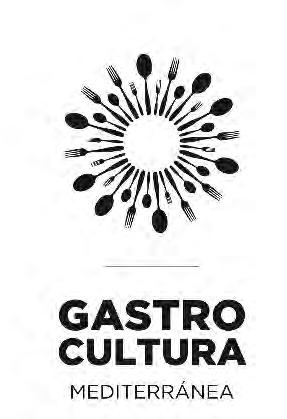GASTRONOMIC APPLICATION OF ENZYMES



Collaborating with:


Enzymes are hitherto unknown ingredients in restaurants, although they have been used in the food industry for years. By using these ingredients in our restaurant, bar or pastry shop, we will have the opportunity to achieve textures that could not be achieved otherwise
We have developed this dossier with the aim of providing knowledge and making known how to use them and the options they can offer us.
That is why we will explain what enzymes are, and we will delve into each one of them so that you can understand them and apply them in your own gastronomic recipes.

ENZYMES: WHAT ARE THEY AND HOW ARE THEY USED
Enzymes are proteins that catalyze (speed up) biochemical reactions that occur naturally in all living organisms.
Enzymes are natural origin proteins present in most plant or animal foods that we consume on a daily basis, and which, applied to food products, can be used to modify some of their properties. They are commonly used to improve and transform products on an industrial scale, but until now very few restoration methods and applications have been developed.

Enzymes, unlike other texturizers, are very specific. This means that each enzyme will only work with one type of fiber or molecule. This compound that reacts is called substrate, and is transformed into the so-called products.

As you can see in the image, for enzymes to work they have to fit the substrate in question, so they will only work when the substrate is compatible

Enzymes are of natural origin. Most have been generated through the fermentation of natural products of plant or animal origin, or even extracted directly from fruits or vegetables.

There are different parameters that can affect the proper functioning and performance of enzymes, and that we will take into account when using them. This occurs due to the shape of the enzyme and the way the substrate fits with it, that is, due to its specificity.
• The product: If the food does not contain the substrate that the enzyme needs, there will be no reaction. So, if we apply pectinase to a food that does not contain pectin, it will not undergo any change.
• Substrate accessibility: The substrate must be accessible for the enzyme, since, if they do not meet and do not fit, no change can occur. The main barrier that we find is the external skin of the vegetables since the impermeability of the skin does not allow the enzyme to penetrate. We will have to make some cuts in the skin, puncture it or peel it so that the enzyme can penetrate.
• Proportion: If there is little substrate, even if we add a lot of enzymes, we will not achieve more effect. If, on the other hand, we have a lot of substrate and little enzyme, it will work, although slowly.
• Temperature: It is one of the most important factors to take into account. The enzyme has a temperature curve on which its activity depends, much like the temperatures used for fermentation:


→ At 0º C or less, the reaction stops because, as the product is frozen, so the two parts cannot fit together. As the temperature rises, this change is recoverable.
→ From 0 to 60°C the enzyme is active. In general, most enzymes have an optimum temperature where their activity is maximum. It is usually between 45°C and 60°C, depending on the enzyme.
→ At 70°C, or more, the enzyme is irreparably destroyed, since by heat the shape of the enzyme is modified and coagulates, so that the substrate can no longer fit with the enzyme anymore.
• Acidity: Enzymes are also destroyed if they leave a certain pH range and become inactive, although in the kitchen it is very difficult to reach these extreme values since they are either too acidic or too alkaline.
We have developed a line of Töufood Enzymes intended for use in restaurants and haute cuisine. This project is still open today and with research in constant development in order to expand the range with a much broader spectrum of applications.

Pectinase is the enzyme responsible for degrading pectin in fruits and vegetables, softening them and giving them a cooked texture, but without cooking.

Cellulase is the enzyme responsible for breaking down cellulose in fruits and vegetables, thus breaking down the hard parts of vegetables.

Invertase is the enzyme responsible for transforming sugar into inverted sugar, enhancing the sweetness of the ingredients and providing them with antifreeze and moisturizing properties.

Amylase is the enzyme responsible for breaking down starch in fruits and vegetables, giving starches creamy textures and adding sweetness.

Glucosidase is the enzyme responsible for degrading the dextrins resulting from the application of amylase. It greatly increases the degree of sweetness of the food.

Lipase is the enzyme responsible for breaking down fats and triglycerides, modifying their aromatic profile and enhancing mature flavors.

Pectinase is the enzyme that degrades pectin, one of the main enzymes in vegetables. Depending on each vegetable, the pectin will be more concentrated in the skin, the interior, or distributed throughout the piece.
Pectin

Greek ‘Pectos- (πηκτος) means ‘coagulated’
Complex polysaccharide present in the vegetables’ cell walls, especially fruits, used as a thickener. It is formed by derivatives of galacturonic acid, so when it breaks, it acidifies the product in which it is found.


By using Pectinäse, we manage to soften various plant parts, such as stems and skins, that we normally discard; peel fruits and vegetables very easily; liquefy, clarify juices, and other applications that we are developing.
In this way, the benefits it brings us are a reduction in production times and costs, an increase in yields and waste management, and an improvement in the properties of the products.

To activate the enzyme, it must be hydrated with water or a non-greasy liquid and put in contact with the pectin of the food. There are three application methods depending on the desired result:
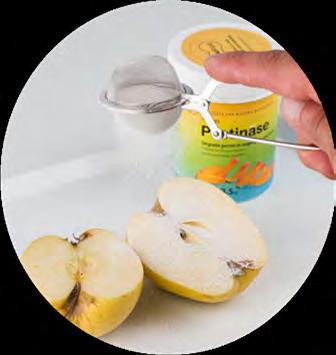


• Impregnation: By previously making multiple holes in the product, and adding the enzymatic solution, we achieve a homogeneous degradation throughout the product.



• Injection: We achieve internal enzymatic degradation while leaving the outside intact.
• Sprinkle or immerse: We manage to degrade the exterior while the interior is left intact.
To obtain maximum performance, it is recommended to peel or puncture the skin over its entire surface and impregnate with 2 or 3 cycles of vacuum at 90-95%, and if desired, carry out a final cycle with sealing.
As mentioned in the introduction, temperature and pH affect the activity and therefore the yield of Pectinase. Pectinase activity graphs for pH and temperature are shown below.


Another factor that must be taken into account for the enzyme to act is the amount of pectin that the food to be treated contains: since pectinase only acts on pectin, it will only work with products that contain it. In general, almost all vegetables contain pectin, to a greater or lesser extent. Depending on the proportion of pectin, and where it is found, we will obtain one result or another.
Below is a brief list of some fruits and vegetables that contain pectin.
High pectin content vegetables: Apples - Lemons - Limes - Oranges - Currants - Plums - Grapes - Quince
- Carrots - Tomatoes - Peas - Olives - Apricots - Sloes – Kiwi
Medium pectin content vegetables: Very ripe apples - Grapefruit - Figs - Pineapples - Pumpkin -
Watermelon - Cantaloupe - Papaya - Potato - Guava - BlackberriesBanana - Rosewood
Low pectin content vegetables: Peaches - Nectarine - Strawberries - Raspberries - Blueberries - Celery
- Bean pods - Cherries - Mango - Pears -Zucchini – Cauliflower


As a result of our research, different techniques applied to this enzyme have been determined. Each technique will provide us with a change in texture and a different result that we will apply according to the consistency we want to achieve.

When pectin is broken down using Pectinäse, the structure of the vegetables it comes into contact with is weakened, significantly changing their texture, and making them softer (this is especially the case with fruits). This process is not instantaneous, and the vegetable loses its shape over time. If the degradation is to be stopped, it will be necessary to heat the product to more than 70ºC, to deactivate the enzyme.
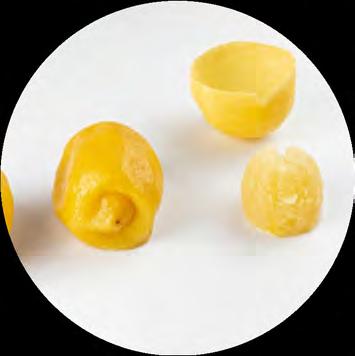




Using pectinase makes it easier to fully exploit this fruit and citrus in general. Once the enzymes have worked, the entire skin can be separated from the segments, the albedo and even the juice sacs , and each of the parts can be used for the desired elaborations.

When the pectin in fruits and vegetables degrades, they soften and change their texture without cooking.



By softening the meat of the coconut with pectinase, a puree texture is obtained while preserving the flavor of the tender coconut. When the pectinase has already acted and the coconut is soft, it can be left attached to the wall of the shell and therefore the finished dish can be served inside the coconut to eat it by dragging the spoon along the walls of the shell.
Pectinase degraded coconut meat can also be carefully removed. The meat will still be firm enough to remove from the coconut and handle, but with a pureed texture when eaten.


Modifying the texture of the strawberry, it goes from being crunchy to being soft on the palate without changing its appearance. This texture causes a light sensation in the mouth and a subtle strawberry flavor.
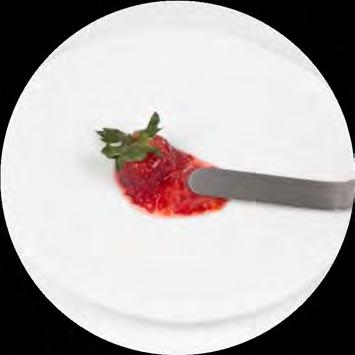

The pectinase softens the leaves, obtaining a cooked texture, but without the need to apply temperature to them. In this way, both the shape and color of the spinach are preserved and all its properties and vitamins are preserved.


In the case of bananas, it is necessary to combine pectinase with cellulase and amylase so that the whole banana is edible without having to be peeled.


You can also use only the skin in preparations. For that, you have to open the degraded banana, and carefully remove the banana pulp from the inside. By tearing the inner part of the skin well, we are left only with the outermost part of the skin, which can be caramelized or crystallized to make a crunch.

Normally it is necessary to remove the first layers of leaves from the artichoke, clean it and cut it down to the core. Combining pectinase with cellulase makes the whole artichoke edible, so it can be used in its entirety.




Impregnating a slice of watermelon with pectinase breaks down the fibrous structure of the fruit, releasing a lot of water and softening the green part near the skin. With this technique the skin becomes edible and provides a flavor similar to cucumber.



If products that have been treated with enzymes are dried, the resulting sugars are concentrated, achieving a final product that is firm on the outside with a creamy interior and a high proportion of its natural sugars


Applying this technique on a fig previously degraded with pectinase, the fruit's sugars are concentrated, providing a more intense flavor and a smoother texture with a compote interior.
Degrading the mango with enzymes allows the interior of the mango to have a compote-like texture, and subsequently semi-drying it creates a surrounding skin that maintains the desired shape and encapsulates the creamy interior of the fruit.



By degrading the fruit using enzymes, its interior is softened and some of the water contained in the fruit is lost, so when candied later in sugar it does not need to be cooked for as long, and the fruit absorbs much less sugar. In this way, a candied fruit is obtained that is less sweet, so the original flavor of the food is enhanced.



Using pectinase, this fruit can be used in its entirety, since the skin and the interior become totally edible. After lightly candied with syrup, the interior of the kumquat looks like jam while the skin remains thick enough to handle or dip in chocolate.
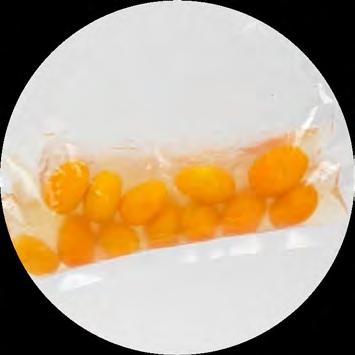
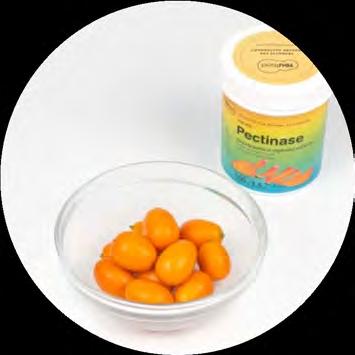
By applying the degradation technique for a very long time, a completely liquid product is obtained, as all the pectin present in the food is degraded. Applying a filtering technique to remove the parts that have not been liquefied, a cold liquefying of the product is obtained


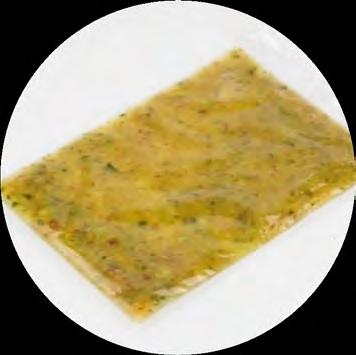




Through the use of enzymes, the juice found in the skin of the pineapple can be extracted since the pectinase degrades all the pulp that remains attached to the skin. In this way it is used in the form of juice with a high yield.


The pectinase allows to obtain the maximum performance in fruits and vegetables, obtaining a high amount of juice from them.


By degrading the soluble fiber that remains when a vegetable is liquefied or squeezed, it separates from the liquid by density and leaves a clarified liquid that maintains all the flavor of the initial ingredient. Since the fibers are broken at the cellular level, much higher yields are achieved than traditional techniques.






We crush the fruit, with its skin, so that the enzyme works optimally, letting the fiber present in the liquid settle by gravity. In this way the fiber is separated leaving in the middle a transparent clarified with all the flavor of the fruit used.

When pectin breaks down, some fibers become soluble and separate from the rest, clarifying vegetable juices.
Given its ability to degrade vegetable fiber, pectinase manages to soften parts of fruits and vegetables that are usually discarded because they are inedible, mostly hard skins. In this way, the vegetable is used in its entirety, without generating practically any loss and considerably increasing the yield that is obtained from the food.




PUMPKIN

There are very few preparations where pumpkin skin is used, since this vegetable has a very hard skin that makes it practically inedible. Only by cooking it for a long time and/or confit it can be used.

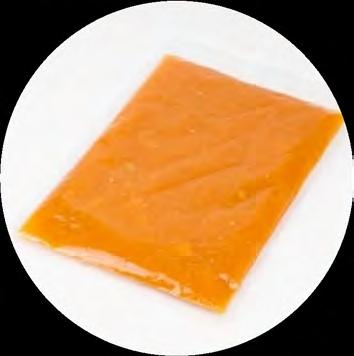
Applying enzymes to the skin allows it to soften enough without any cooking method so that it can be used in multiple recipes. Even so, there are certain parts in which the enzyme cannot act, so it will be advisable to strain the result of the degradation.


Pectinase makes it possible to make the most of fruits and vegetables, and even use parts that are normally discarded: the waste.
If the enzyme acts only on the skin, the degradation that occurs can be used to make it easier to peel the products.


Generally, much of the pectin in fruits and vegetables is found in their skin, so applying pectinase only to the surface breaks the fiber that forms the skin and softens it, allowing vegetables to be peeled very easily






Submerging the whole almond nut in pectinase will cause its skin to come off with light pressure from your hands. This greatly facilitates a process that would be very laborious, and allows the extraction of tender almonds or crystal almonds without much effort.



By applying the pectinase to the skin of the legumes, it is possible to remove the skin without having to resort to any type of cooking by temperature. Since the enzyme only acts on the skin, the interior remains completely intact, with the natural texture and flavor of the legume.




Collaborating with:



For the simple syrup
200 g water
200 g sugar
For the lemon peel
2 medium lemons
500 g water (I)
15 g Töufood Calx
200 g water (II)
10 g Töufood Pectinäse
200 g simple syrup (previous preparation)
1. Put the water with the sugar in a saucepan, bring to the boil and reserve.
1. Put the lemons in the mixture of Cälx and water (I) for 3 hours, stirring the mixture every 15 minutes.
2. Once the time has passed, take out the lemons and wash them very well.
3. Prick the surface of the lemons with a needle and pack the lemons with the mixture of Pectinäse and water (II).
4. Leave in refrigerator for 12 hours.
5. Take the lemons out of the bag and cook in a pot covered with syrup over low heat for half an hour, until they are tender. Allow to cool.
6. Very carefully, empty them with a spoon, scratching the walls well, so that we have the whole skin and completely clean of albedo. Reserve in the fridge.
For the scalded lemon peel
100 g lemon peel
1500 g water
14 g salt
For the lemon ice cream
50 g cream
20 g Töufood Invërt Sugar

100 g sugar
150 g water
2 g ice cream stabilizer
175 g lemon juice
100 g scalded lemon peel (previous preparation)
1. Peel the lemon and remove the albedo well.
2. Blanch the lemon skins 4 times in the salted water. Reserve.
1. Place the liquids in a saucepan and raise to 35º C.
2. Add the solids in the form of rain, stirring with a wire whisk and raise to 82ºC.
3. Add the lemon peel and leave to infuse for 24 hours in the fridge.
4. Blend in the food processor until a fine paste is obtained.
5. Pass through a fine strainer and reserve for 12 hours in the refrigerator.
6. Churn the ice cream and store in the freezer.
For the lemon foam
150 g pasteurized egg white
140 g lemon juice
80 g gin
4 g Töufood Fishgël

16g water
30 g pasteurized egg yolk
105 g simple syrup (previous preparation)
1 u lemon
2 siphon charges
Other Basil sprouts
Molasse
Greek yogurt
1. Mix the lemon juice with the gin and the pasteurized egg white, add the grated skin of 1 lemon and leave to macerate for 30 minutes in the fridge.
2. Heat the yolks with the TPT to 65° C.
3. Add previously hydrated Fishgël and mix until dissolved.
4. Strain the lemon juice mixture and mix with the yolks.
5. Pour everything into a siphon, charge with two N2O charges and cool.
6. Reserve in the refrigerator for 6 hours to gel.
1. Place the lemon ice cream until half a lemon is filled.

2. Add a few lemon wedges, a few drops of molasse and a little Greek yogurt.
3. Fill with the foam, finish with some basil leaves and a few drops of molasse.
4. It should be eaten by sticking the spoon and accompanying it with the skin, since when treated with enzymes it is totally edible.
For the coconut meat
1 green coconut
1 g Töufood Pectinäse

100 g water
1. Dilute the Pectinase in the water.
2. Open the coconut in half, clean it well and make several punctures in the meat with a needle.
3. Vacuum pack the coconut with the pectinase and water solution. Leave to act 24 hours in the refrigerator.
4. Scoop out the coconut meat with a spoon, being very careful not to break it.
5. Cut squid-shaped triangles and store in the fridge.
For the squid tartar
1 big squid
Salt
EV olive oil
For the squid broth
300 g squid guts
(previous preparation)
50 g onion
50 g olive oil
40 g white wine
500 g water
15 g squid ink
1. Remove the insides of the squid and the fins, which we will keep for future preparations.
2. Remove the squid skin and the hard parts from the ends.
3. Chop the squid with a knife to obtain a very fine tartare.
4. Season with the oil and salt and set aside.
1. Cut the fins and the toughest parts of the squid into 1 cm cubes and fry in oil.
2. When they are well browned, add the chopped onion and fry until the onion has a nice golden color.
3. Add the insides of the squid and the ink, and cook.

4. Add white wine and let evaporate.
5. Add the water and let it stew for half an hour.
6. Strain and reserve.
For the coconut squid
Coconut meat (previous elaboration)
Squid tartar (previous elaboration)
For the ink sauce
200 g coconut milk
200 g squid broth (previous elaboration)
Squid ink Salt
1. Place the tartar in the center of the softened coconut meat triangle and distribute it in the shape of a squid.

2. Close the ends to form a cone shape and store with the closure at the bottom.
1. Reduce the coconut milk to 70 g.
2. Add the broth and emulsify in Thermomix.
3. If necessary, add more squid ink, season with salt and reserve.

1. Heat slightly and place two tablespoons of ink sauce on the plate.
2. Place the tempered stuffed squid in the center.
3. Finish by putting the fried tentacles on top of the squid.
For the coconut with pectinase
1 green coconut
1 g Töufood Pectinäse

100 g water
1. Dilute pectinase in water.
2. Open the coconut in half, clean it well and make several punctures in the meat with a needle.
3. Vacuum pack the coconut with the pectinase and water solution. Leave to act for 24 hours in the fridge.
For the shrimps
4 medium shrimps
For the shrimp broth
400 g water
125 g Shrimp shells (previous elaboration)
125 g ripe tomato
10 g garlic
1 g sweet smoked paprika
1 g fresh parsley
Olive oil
1. Peel the shrimp and remove the intestines.
2. Save the shells for the broth and the clean body for the final dish.

1. Heat a little oil in a saucepan, add the shrimp shells. Sauté 20 seconds over high heat and remove.
2. In the same saucepan add a little more oil and add the cloves of garlic cut in half with skin. When they start to brown, add the parsley, stir a couple of times, add the paprika, stir twice and quickly add the grated tomato.
3. Cook the whole until the tomato evaporates all its water.
4. Add the shrimp shells and cook with the rest of the sauce for two minutes.
5. Add the water, bring to a boil and lower the heat to a minimum.
6. Skim and cook for 20 minutes.
7. Cover the pot with plastic wrap and leave to infuse for another 20 minutes.
8. Pass through a fine strainer and store in the fridge for 4 hours in a tall, narrow container so that excess fat stays on top.
9. Remove the fat and reserve.
For the red curry sauce
200 g coconut milk
5 g red curry paste
200 g shrimp broth (previous elaboration)

10 g butter
Salt
For the basil oil
100 g basil
100 g olive oil
5 g Töufood Glycë

1. Reduce the coconut milk by half, along with the red curry paste.
2. Put in the food processor and add the broth.
3. Emulsify while adding the butter.
4. Add salt to taste and set aside.
1. Defoliate the basil and blanch the basil leaves in boiling water for 6 seconds.
2. Cool rapidly in ice and water.
3. Drain and grind the basil leaves with the mild olive oil in the food processor at 80ºC until a fine oil remains.
4. Strain through a fine mesh sieve.
5. Heat a small part of the oil to melt the Glycë, mix with the rest and reserve in a small pipping bag.
For the coconut dices
½ coconut (previous elaboration)
Other
Basil sprouts, coriander sprouts, dill sprouts, garlic flower, 1 lime
1. Scoop out the green coconut meat with a spoon.
2. Cut 5mm cubes.
1. Season two prawns and place inside the coconut.
2. Arrange 5 fresh coconut squares.
3. Add the curry sauce.
4. Put 5 basil oil points.
5. Finish with sprouts and lime zest.
For the strawberries with enzymes
100 g strawberries
100 g water
0,5 g Töufood Pectinäse

1. Dilute pectinase in water.
2. Prick the strawberries at various points with a needle.
3. Pack the strawberries with the pectinase mixture, well placed in a bag.
4. Leave to act for 30 minutes, until the strawberry is soft but still maintains its structure.

5. Put in the dehydrator another 30 minutes.
For the strawberry water
100 g strawberries
10 g white sugar
For the strawberry sauce
45 g strawberry
50 g strawberry water (previous elaboration)
9 g clarified butter
4,5 g pink peppercorns
Salt Black pepper
1. Cook the strawberries with the sugar in the microwave at 900W for 15 minutes, covering the container with plastic wrap.
2. Allow to decant in a fine chinois.
3. Reserve cold in an airtight container.
1. Combine all the ingredients in a saucepan.
2. Simmer over low heat for 1 hour.
3. Season with salt and pepper.
4. Strain and keep cold in an airtight container.
For the burnt milk ice cream
60 g white sugar
300 g evaporated milk
110g fresh sheep milk
2 g ice cream stabilizer
90 g cream 35%
25 g Töufood Dextröse

Other Black pepper
1. Mix the sugar, stabilizer and dextrose.
2. Heat the milk and cream to 40°C.
3. Add the dry mix and raise to 82°C. Chill.
4. Burn the mixture with the burning paddle.
5. Cool and churn the ice cream.
6. Store in the freezer at -14º C.
1. Place the strawberry on the side of a concave plate.

2. Add the strawberry sauce in the center.
3. Place a quenelle of ice cream next to the sauce and add a little freshly ground pepper.

For the “cooked” spinach
30 g spinach leaves
100 g water
0,5 g Töufood Pectinäse

For the pine nut paste
200 g pine nut
20 g sunflower oil
Salt
For the hydrated raisins
30 g raisins
30 g stale wine
For the fumet (stock)
200 g fish bones
400 g water
50 g onion
For the garlic oil
100 g olive oil
50 g garlic cloves
1. Dilute pectinase in water.
2. Vacuum pack the spinach leaves with the pectinase solution and leave for 30 minutes in the fridge.
3. Remove from the bag and set aside.
1. Toast the pine nuts in the oven at 180°C between 8 and 10 minutes until golden brown.
2. Put the toasted pine nuts with the oil in a stone grinder to obtain a fine paste.
1. Put the raisins to hydrate with the stale wine for 2 hours.
1. Boil the bones and the chopped onion in the water for 25 minutes.
1. Put the garlic with the oil in a frying pan over a very low heat for 1 hour.
2. Remove, strain and reserve.
For the cod pil pil
140 g fumet (previous elaboration)
60 g garlic oil (previous elaboration)
0,4 g Töufood Xanthän

For the cod stew
100 g cod guts (previous elaboration)
100 g cod pil pil (previous elaboration)
1. Blend the Xanthan with the fumet.
2. Add the garlic oil little by little while emulsifying with a blender. Reserve.
1. Arrange the pil pil in a saucepan along with the minced cod guts.
2. Heat stirring gently and set aside.
1. Put 3 tablespoons of hot cod stew on the plate.
2. Place 4 degraded spinach leaves to one side.
3. Arrange a few toasted pine nuts on top and 3 hydrated raisins over the stew.
4. Finish with a string of pine nut paste around the stew.

For the enzymes mix
100 g water
5 g Töufood Pectinäse
5 g Töufood Celluläse
5 g Töufood Amyläse
For the degraded banana
4 bananas
115 g enzyme mix (previous elaboration)
Töufood Ascorbïc

For the banana cooked in lime
4 degraded bananas (previous elaboration)
50 g simple syrup
50 g lime juice
For the crispy banana peel
4 bananas cooked in lime (previous elaboration)
50 g simple syrup
Töufood Silïcagel
1. Mix the water with the enzymes and set aside.
1. Prick the bananas and reserve in a water bath with ascorbic acid.
2. Arrange the bananas in a bag with the enzyme mix and pack with the heat sealer, so that the banana does not break.
3. Leave to act for 12 hours in the fridge
1. Remove the bananas from the enzymes and place them in a bag with the syrup and lime juice.
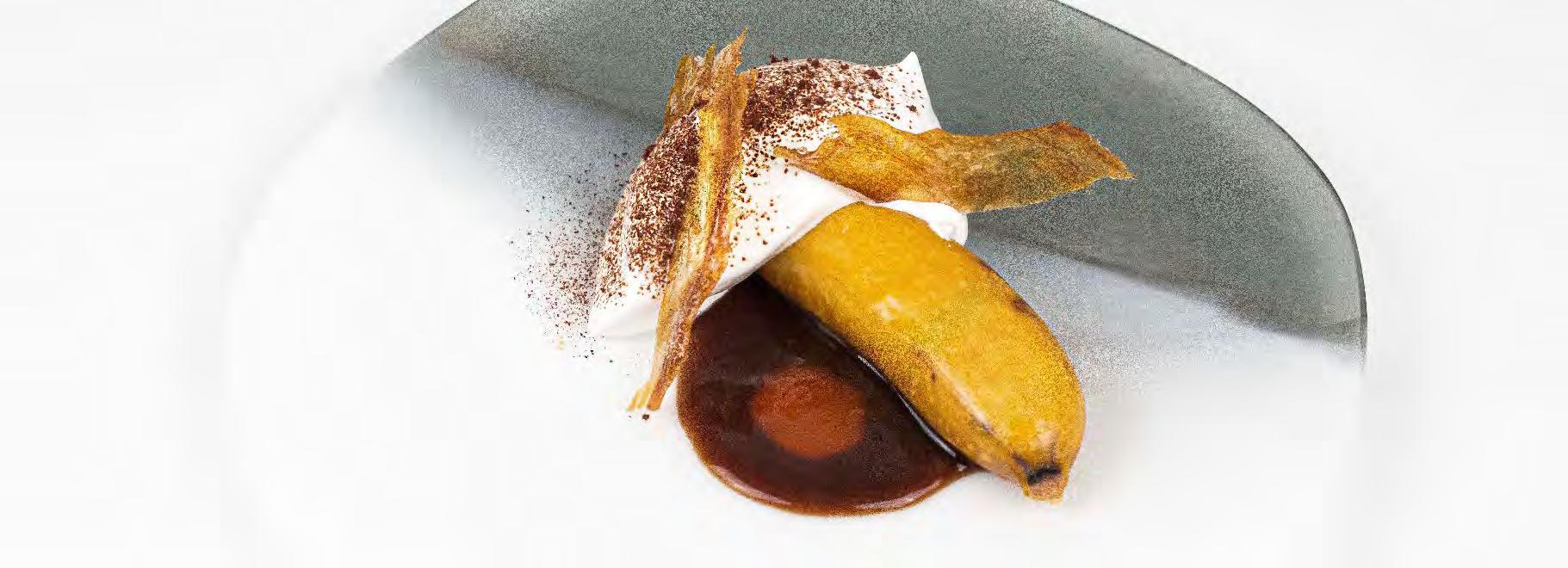
2. Close with the heat sealer and cook in a steam oven at 80°C 100% steam for 35 minutes.
3. Cool and reserve in the refrigerator.
1. With a lace, carefully open the banana on one side. Remove the pulp.
2. Tear the banana skins leaving only the outermost part.
3. Arrange the torn skins in a container with the TPT syrup and impregnate several times with the vacuum packer.
4. Spread on a silpat in a baking tray and crystallize in the oven at 160°C for 10/15 minutes, until crispy.
5. Cool the skins on a flat surface.
6. Reserve in an airtight container with Silïcagel.
For the coffee infusion
400 g milk
30 g coffee beans
For the coffee ice cream
400 g coffee infusion (previous elaboration)
100 g cream 35%
25 g Töufood Glucöse 35
30 g sugar
5 g Töufood Dextröse
12 g ice cream stabilizer
For the passion fruit reduction

500 g passion fruit pulp
50 g Töufood Glucöse Syrup
For the OCOO banana
3 u banana
1. Infuse for 24 hours, vacuum-packed.
2. After 24 hours strain and reserve.
1. Place the infused milk, cream and glucose in a saucepan and heat to 35ºC.
2. Add all the dry ingredients and mix with a hand mixer.
3. Leave to mature for 24 hours in the refrigerator.
4. Churn the ice cream and freeze at -12ºC.
1. Mix passion fruit pulp with glucose and reduce to 200 g.
2. Reserve
1. Peel the bananas.
2. Put the bananas in the perforated container of the OCOO and cook with the “Black Egg” program for 5 hours. Reserve 24 hours in the machine when the program ends.
3. Reserve the bottom juice.
For the banana sauce
100 g OCOO banana juice
(previous elaboration)
0,5 g Töufood Xanthän

1. Mix the black banana juice with the xanthan and blend until thick.
2. Strain the juice and remove excess air with a vacuum machine.
For the lime marshmallow
110 g water
120 g sugar
12 g Töufood Glucöse Syrup
60 g egg whites
2 g Töufood Egg Albümin
4 g Töufood Fishgël

160 g lime juice
1 lemon
Other Instant coffee
1. In a bowl, mix the egg whites with the Albumin Egg.
2. In another container, heat the water and the Glucöse Syrup to 113ºC.
3. Whip the egg whites at medium speed.
4. When the syrup reaches 118ºC, remove from heat and add to the meringue, whipping at low speed.
5. Increase speed until mounted.
6. Heat 60g of lime juice with the hydrated Fishgël and stir until the gelatin is dispersed and mix with the rest of the cold juice.
7. Gradually add the juice to the meringue and beat until smooth.
1. Arrange the banana sauce at the bottom of the plate. Cover with a point of reduction of passion fruit.
2. Place the degraded plantain cooked in lime on the sauces.

3. Place a quenelle of the coffee ice cream on one side and cover with the lime cloud.
4. Finish with a few pieces of crunchy banana skin and sprinkle instant coffee over the cloud of lime.

For the enzymes mix
100g water
5g Töufood Pectinäse

5g Töufood Celluläse
For the degraded artichoke leaves
200g whole artichoke
100g enzymes mix (previous elaboration)
Other
30g parmesan cheese
30g olive oil
1g salt
1. Mix enzymes with water.
1. Defoliate the artichoke keeping all the leaves.
2. Put the artichoke leaves with the enzyme mix in a vacuum bag and vacuum impregnate.
3. Let the enzymes act for 24 hours.
1. Arrange the artichoke petals on a plate forming a flower.
2. Grate p armesan cheese in the center of the flower.
3. Lastly, add a dash of olive oil and a little salt on top.
For the candied kumquats
2 medium sized kumquats
500 g water (I)
15 g Töufood Cälx

200 g water (II)
10 g Töufood Pectinäse
200 g simple syrup
1. Mix 500 g of water with the Cälx.
2. Put the kumquats in the Cälx for 1 hour, stirring every 15 minutes.
3. Take out the kumquats and wash them very well.
4. Prick the kumquats until you reach the center.
5. Dilute the pectinase in the water and pack with the kumquats. Leave in the fridge for 2 hours.
6. Remove the kumquats from the bag and cook in a pot covered with syrup over low heat for 30-40 minutes. Let cool.
7. Carefully remove the seeds with tweezers.
For the kumquat orangettes
Candied kumquats (previous elaboration)
300g 70% black chocolate
1. Temper the dark chocolate, giving it a curve of 50ºC /29ºC /31ºC, and cover the kumquats.
2. Remove excess chocolate and allow to crystallize at room temperature.


For the semi-dried fig
4 figs
100 g Pedro Ximenes wine
1 g Töufood Pectinäse
For the PX reduction
100 g Pedro Ximenes wine
10 g Töufood Glucöse Syrup
For the fig leaf cream
50 g cream 35%
50 g fig leaf
For the pecan nut paste
100 g pecan nut
10 g sunflower oil
Salt
For the PX ice cream
250 g milk
15 g Töufood Skimmed Mïlk

100 g cream 35%
75 g sugar
20 g Töufood Glucöse 35
35 g yolk
200 g sour cream
40 g Pedro Ximenes wine
2 g ice cream stabilizer
1. Dilute the Pectin in the PX.
2. Prick the figs on the surface and pack the figs with the Pectinase and PX mixture. Leave 12 hours in the fridge.
3. Remove from bag, drain, and dry in dehydrator for 6 hours, turning every half hour.
1. Mix the PX with the Glucöse Syrup.
2. Reduce over medium heat until you get a liquid caramel texture.
1. Blanch the fig leaves.
2. Boil the cream and add the leaves, leave to infuse for 12 hours.
3. Strain and mount with a whisk.
1. Toast the nuts in the oven at 180ºC for 8 minutes.
2. Blend at minimum power while still hot in a food processor.
3. Add the oil to facilitate processing.
4. Once we have a fine paste, season with salt and set aside.
1. Put milk and cream in a saucepan, raise it to 40ºC and add the yolk.
2. Add the previously well-mixed dry ones.
3. Heat the assembly without stopping stirring until reaching 82ºC.
4. Pour over the cold sour cream, mix well and leave in the fridge for 12 hours.
5. Add the PX, mix well and churn.
6. Reserve in the freezer.
Töufood Mälto Tapioca

1. Place a tablespoon of pecan paste at the base of the plate.
2. Add 5 small pieces of pecan nuts.
3. Place a quenelle of ice cream on top of the pecan paste, which we will smooth slightly with a spoon so that we can place the fig on top.
4. Around the ice cream place an XP reduction thread.
5. Add a tablespoon of fig leaf whipped cream.
6. Coat the fig in Töufood Mälto Tapioca, remove the excess and place the fig on top, in the center of the cream.
7. Finish with elderflowers.
For the syrup 40%
180 g sugar
420 g water
For the mango date
500 g water (I)
15 g Töufood Cälx

1 ripe mango
100 g water (II)
5 g Töufood Pectinäse
500 g syrup 40% (previous elaboration)
1. Put the ingredients in a saucepan and bring to a boil.
1. Mix the 500 g of water with the Cälx.
2. Peel the mango and cut it into the shape of a date.
3. Leave the mango dates for 30 minutes in the Cälx bath, stirring them continuously.

4. Take out and clean well in plenty of cold water.
5. Mix pectinase with water.
6. Prick the dates with a needle and vacuum impregnate them with the pectinase bath.
7. Put them in the dehydrator at 50ºC for 1 hour.
8. Cook in syrup for 10 minutes.
9. Introduce in the OCOO with the “Black Egg” program for 2 hours.
For the lime reduction
250 g lime juice
50 g sugar
Other Orange
1. Mix lime juice with sugar.
2. Reduce until a dense texture is obtained.
1. Paint the dates with the lime reduction.
2. Place on a plate and grate orange peel on top.
For the tepache
700 g pineapple peel
1 L water
150 g panela sugar
5 g Töufood Pectinäse

1. Pour the water into a container and add the sugar.
2. Mix the pectinase in the previous solution.
3. Add the pineapple skins to the container, ensuring that they are completely submerged.
4. Ferment 4 days at 20ºC with an airlock to release the gas generated.
5. Fill an airtight bottle with the fermented tepache and reserve in the refrigerator for 3 days to generate carbonation.

For the degraded grilled melon balls
250 g cantaloupe
100 g water
2 g Töufood Pectinäse
For the melon clarification
250 g cantaloupe
5 g Töufood Pectinäse
1. Grill the melon until it is well browned.
2. Prick with a needle and pack with the water and pectinase.
3. Let it act in the fridge for 2 hours.
4. Scoop out balls from the degraded melon and store in the fridge.
1. Cut the melon into slices and mark on the griddle.
2. Blend, add pectinase and leave to clarify in the fridge for 6 hours in a tall container.
3. With a syringe remove the crystal-clear water and reserve in the refrigerator.
For the ham broth
200 g Iberic ham
800 g Iberic ham bone
1200 g water
For the ham gel
200 g ham broth (previous elaboration)
2 g Töufood Fishgël

8 g water
Other
EV Olive oil
1. Chop the ham, add it to the water and the bone.
2. Simmer for 1 hour and strain.
3. Strain through absorbent paper and keep aside.
1. Dilute the previously hydrated Fishgël in a small part of the ham water.
2. Heat until the gelatin is dispersed and mix with the rest of the ham water.
3. Add 50 g of this mixture to the plate and leave to set in the fridge.
1. Place 4 grilled melon balls on the ham jelly.
2. Finish with a few drops of virgin olive oil and melon juice.

For the enzyme mix
100 g water
5 g Töufood Pectinäse
5 g Töufood Celluläse
5 g Töufood Amyläse

For the pumpkin juice
500 g whole pumpkin
100 g enzyme mix (previous elaboration)
For the pumpkin, orange, carrot and ginger juice
500 g pumpkin juice (previous elaboration)
500 g orange juice
120 g carrot juice

15 g ginger
1. Disperse pectinase, cellulase and amylase in water.
2. Reserve.
1. Crush the pumpkin with the skin with the enzyme mix.
2. Vacuum pack and leave for at least 24 hours.
3. Strain with superbag.
4. Introduce the liquid in a vacuum bag and pasteurize in a steam oven at 60°C for 1 hour.
1. Grate the ginger.
2. Add the grated ginger to the pumpkin juice and leave to stand for at least 30 minutes.
3. Mix the juices, strain and reserve in the fridge.
For the enzyme mix
100 g water
5 g Töufood Pectinäse
5 g Töufood Celluläse
5 g Töufood Amyläse

For the pumpkin juice
500 g whole pumpkin
100 g enzyme mix (previous elaboration)

For the pumpkin cream
500 g de pumpkin juice (previous elaboration)
400 g water
55 g onion
30 g noisette butter
4 g salt
1. Disperse pectinase, cellulase and amylase in water.
2. Reserve.
1. Crush the pumpkin with the skin with the enzyme mix.
2. Vacuum pack and leave for at least 24 hours.
3. Strain with superbag. Introduce the liquid in a vacuum bag and pasteurize in a steam oven at 60°C for 1 hour.
1. 1. Blend all the ingredients until a cream with a certain consistency is obtained.
2. 2. If a thicker texture is desired, add a small cooked potato.
For the enzyme mix
100 g water
5 g Töufood Pectinäse
5 g Töufood Celluläse
5 g Töufood Amyläse

For the pumpkin jam
445 g whole pumpkin
100 g enzyme mix
(previous elaboration)
130 g sugar
80 g orange juice
1 cinnamon stick
4 g Töufood Pëctin HM Basic
1. Disperse pectinase, cellulase and amylase in water.
2. Reserve.
1. Blend the pumpkin with the enzyme mix.
2. Vacuum pack and leave for at least 24 hours.
3. Heat the pumpkin juice to 70ºC along with the cinnamon and keep it for 10 minutes.

4. Combine the pumpkin with the sugar, pectin and orange juice.
5. Reduce until you get the right texture.

For the peeled almond
50 g almond nuts
100 g water
1 g Töufood Pectinäse
1. Dilute pectinase in water.
2. Vacuum pack the almond nuts along with the pectinase solution. Leave to act 24 hours in the refrigerator.
3. Remove from the bag and peel the outer layer of the almond nut skin.
4. Reserve the peeled almond nuts.
For the pickled almond
50 g peeled almond (previous elaboration)
3 g black peppercorn
40 g apple vinegar
40 g sugar
40 g water
For the tender almond
100 g almond nuts
For the crystal almond
50 g tender almond (previous elaboration)
50 g water
0,5 g Töufood Pectinäse

For the clean bone
1 half cut bone
200 ml peroxide
1. Mix pepper, apple cider vinegar, sugar and water.
2. Put the mixture in a saucepan over medium heat and bring to a boil.
3. Add the peeled almond nuts and let stand for at least 12 hours in the fridge.
1. 1. Open the almond nuts on one side with a knife and remove the tender almond from inside.
1. Dilute the pectinase in water.
2. Vacuum pack the tender almonds along with the pectinase.
3. Leave to act for 12 hours in the fridge.
4. Drain and peel the almonds. Laminate and reserve in the refrigerator between moist paper.
1. Remove all the marrow from inside the bone and reserve for another preparation.
2. Boil the bone in water and scrape it clean.
3. Place the bone in a container covered with hydrogen peroxide and leave for 24 hours until the bone is completely white.
4. Thoroughly clean the bone and dry.
5. Place parchment paper on the bone ends and film to seal the ends.
For the almond milk
200 g almond
200 g water
Salt
For the almond inulin
200 g almond milk (previous elaboration)
60 g Töufood Inülin

Clean bone (previous elaboration)
For the melted marrow
50 g marrow (previous elaboration)
Salt
For the fried marrow
50 g marrow (previous elaboration)
Salt
1. Place the almonds and the water in a container to hydrate for 24 hours.
2. Blend in the food processor for 3 minutes until a smooth paste is obtained.
3. Strain through a superbag and add salt to taste.
4. Reserve in the fridge.
1. Blend almond milk with Inulin at maximum power for 8 minutes.
2. Remove the air in the vacuum machine and dose into the bone that was previously prepared.
1. Put the marrow in ice water for 12 hours to clean it.
2. Cut some cubes of marrow that we will keep frozen for the next preparation and put the cuts to melt over low heat.
3. Season with salt, strain and pour a thin layer over the curdled almond inulin.

1. Put the frozen marrow cubes in a saucepan over the heat from cold.
2. Sautee until they lose some fat, but still maintain their shape and season with salt.
1. Take out the bone and temper for a few minutes.
2. Place two pickled almond nuts and 3 cubes of fried marrow on the bone.
3. Arrange a few slices of crystal almonds between the almond nuts.
4. Finish with a few crystals of salt on the almond, the almond nut and the marrow.

For the peeled peas
100 g peas
50 g water
0,5 g Töufood Pectinäse

1. Dilute pectinase in water.
2. Put the peas in the pectinase solution and let it act for at least 30 minutes.
3. Wash the peas in water while they are peeled, applying light pressure, being careful not to break them.
4. Reserve.
For the black coconut
1 coconut
1. Split the coconut in half and place both halves in the OCOO using the “Black Egg” program for 7 hours. Reserve the water for other preparations.
2. Reserve one half for plating and remove the meat from the other half without breaking it.
3. Cut 4x2 cm rectangles and make shallow cuts at the base with a sharp knife. Reserve.
For the squid tartar
1 squid
Salt
Olive oil
1. Remove the insides of the squid and the fins, which we will keep for future preparations.
2. Remove the squid skin and the hard parts from the ends.
3. Chop the squid with a knife to obtain a very fine tartare.
4. Season with the oil and salt and set aside.
For the yolk sauce
200 g yolk Salt
Other Mint sprouts
1. 1. Place the yolk in a bain-marie and heat constantly moving with a spatula, until we get a thicker but lighter texture.
2. 2. Season with salt and reserve.
1. Place two tablespoons of squid tartar in the black coconut.

2. Cover almost entirely with the egg yolk sauce.
3. Arrange three rectangles of peppered black coconut.
4. Finish by putting a spoonful of peas in the center, seasoned with salt and oil, and a few mint leaves.


Collaborating with:


